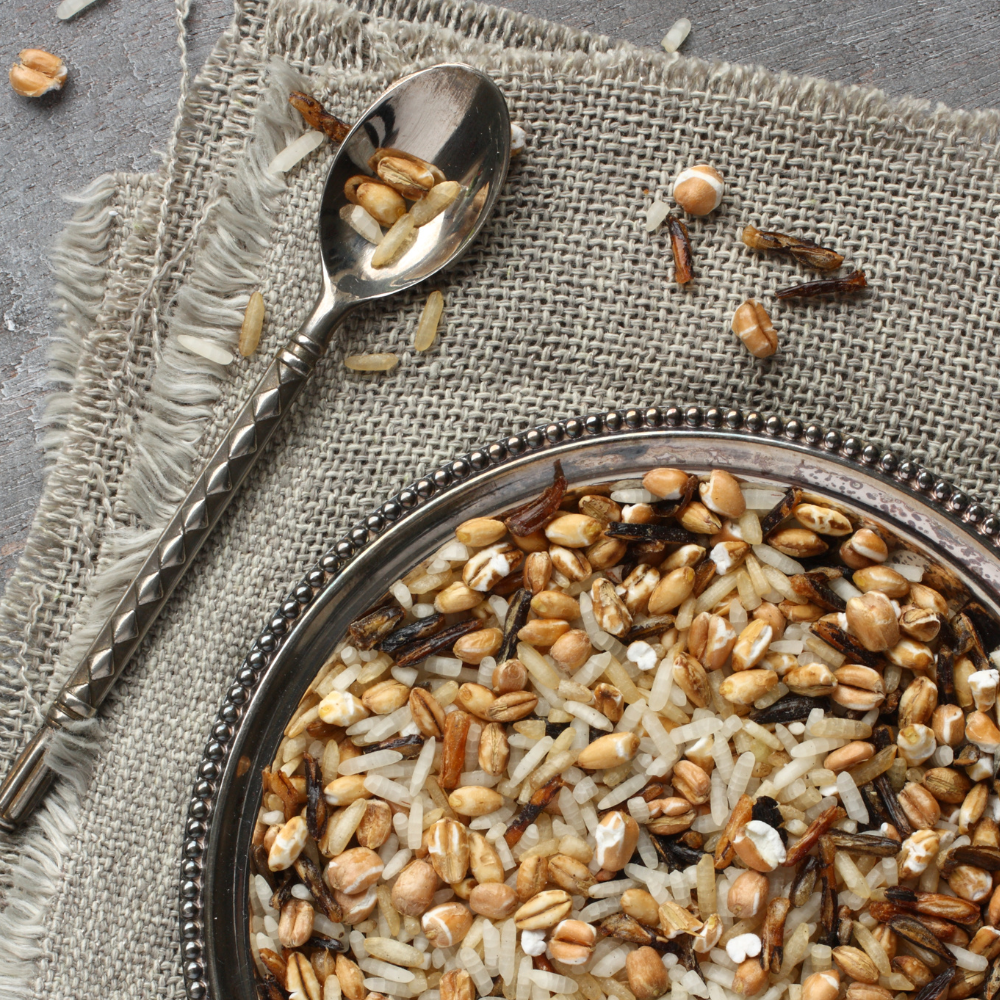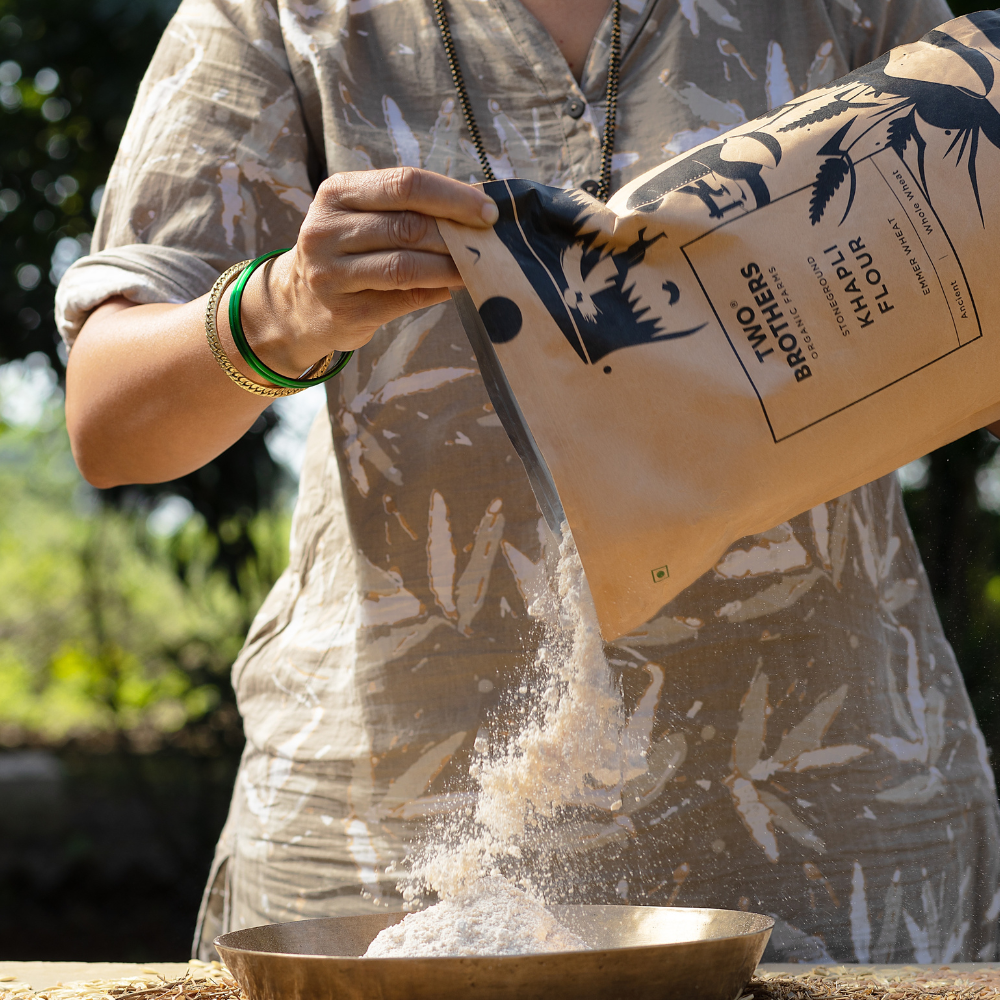Wheat is consumed in different forms by one-third’s world’s population. Its versatility is a perfect carrier for various cuisine. In India, the commonly used wheat products are atta or wheat flour, maida or refined wheat flour, suji or semolina, pasta and daliya or broken wheat grains.
However, do you know that all wheat flours don’t have the same amount of nutrients?
Yes! So, be attentive as we unfold the nutritional value of daily staple atta in this read.
Protein, folate, zinc, iron and other atta nutrients make wheat an irreplaceable part of several households' nourishing meals. Fortunately, there are various native wheat varieties: Emmer/ Khapli, Bansi, Einkorn, Spelt etc that has a good dose of these key atta nutrients.
Including these atta nutrients in the diet can benefit your health immensely. Stay with us till the end to know about the benefits of atta nutrients.
Before that, let's look closely at different aspects of making the best quality whole wheat atta that’s packed with atta nutrients.

|
Table of Content
|
Why should you consider whole wheat flour atta?
The reason why not all wheat flour has the same nutrients lies in the following three factors:
1. Wheat Variety:
Buying organic atta is not enough anymore to ensure the quality of the wheat flour. You must dig deeper to find the grain variant used for making organic wheat flour. The best quality wheat grain has all the atta nutrients.
Here are a few native wheat varieties with higher nutrient content than hybrid or common wheat flour.
- Khapli or Emmer Wheat
- Bansi Wheat
- Sharbati Wheat
- Einkorn Wheat
- Spelt Wheat
Among the aforementioned wheat varieties, khapli wheat is known to have low gluten content, low glycemic index and higher protein content than other varieties of wheat.
While regular wheat flour is made from the genetically modified wheat variety, which has a high glycemic index – a major cause of diabetes and high gluten content– hard to digest.
2. Atta Nutrients Depend on the Content of the Wheat Used in Making Flour/Atta
A wheat seed has three parts or layers: germ, bran and endosperm. Each layer is rich in different nutrients. To make sure to avail all the nutrients, the whole seed must be used to make the flour.
Regular wheat atta is made only from the endosperm of the wheat seed. Hence, it lacks various atta nutrients. On the contrary, whole wheat flour has all the parts of the grain and has more nutrients.
3. The Process of Grinding the Wheat
The traditional practice involves the use of stone chakki or hand mill for grinding whole wheat. But with the advancement in milling technology, the traditional way has faded away.

The high-speed machine grinding destroys the nutrients in wheat. The final product is deprived of fibre and other atta nutrients.
Now you know! Organic whole wheat flour should be processed with care just like our wise ancestors did. Using native wheat grains and stone chakki to mill the grain protects the nutrients and adds an earthy flavour to the atta.
With that being said, let’s see the nutrients in the regular and the organic high-quality whole wheat flour/atta.
Nutritional Value Of Daily Staple Atta: Regular Wheat Flour and Organic Whole Wheat Flour
Organic whole whet flour is the house of essential nutrients required for the body’s better metabolic functions. Whole wheat flour has a balance of essential atta nutrients that are necessary for crafting a healthy meal.
The table below gives a fair idea about how healthy an atta made from whole wheat grain can be.
|
Atta Nutrients |
Regular Wheat Flour |
Whole Wheat Flour |
|
Energy (kcal) |
364 |
340 |
|
Protein (gm) |
10.3 |
13.2 |
|
Total fat (gm) |
1 |
2.5 |
|
Carbohydrates (gm) |
73.6 |
61.3 |
|
Fibre (gm) |
2.7 |
10.7 |
|
Calcium (gm) |
15 |
34 |
|
Iron (mg) |
1.2 |
3.6 |
|
Magnesium (mg) |
22 |
137 |
|
Phosphorus (mg) |
108 |
357 |
|
Potassium (mg) |
107 |
363 |
|
Sodium (mg) |
2.0 |
2.0 |
|
Zinc (mg) |
0.7 |
2.6 |
|
Thiamin (B1) (mg) |
0.1 |
0.5 |
|
Riboflavin (B2) (mg) |
0.04 |
0.2 |
|
Niacin (B3) (mg) |
1.3 |
5 |
|
Vit. B6 (mg) |
0.04 |
0.4 |
|
Folate (DFE) |
26 |
44 |
Source: USDA
The difference in both categories of atta nutrients value is significant. You can see that whole wheat flour has a good amount of folate, niacin and zinc which are essential nutrients. Other than that, whole wheat flour is also abundant in protein, carbs, phosphorus, magnesium, potassium and dietary fibre.
Let’s move on to explore how these atta nutrients help our body to maintain a healthy physical and mental state.
Benefits of Whole Wheat Atta Nutrients
A good quality wheat flour will fill your meal with the goodness of its nutrients like protein, carbs, minerals and vitamins. Your gut will thank you for including a chapati made from high-quality organic wheat like Khapli, Bansi, etc for its various benefits.
-
Protein composition in whole wheat flour
A 100 gm of whole wheat atta has about 14 gm of protein. Wheat protein has albumins, glutenins, globulins, and gliadins. Glutenin is present in the endosperm and the gliadins and globulins are found in all three parts of wheat.
Benefit:
The flour made from whole wheat thus has a balanced proportion of proteins and prevents the sudden sugar spike in blood, which is commonly seen after ingesting regular wheat flour products.
Whereas, regular wheat flour is rich in glutenin and only has traces of albumins, globulins and gliadins. We all are aware that gluten is hard to digest.
-
Carbohydrate composition in whole wheat flour
Other important atta nutrients found in whole wheat are carbohydrates: amylose and amylopectin.
Benefits:
The carbohydrates are easily broken down by the digestive juices/saliva and provide instant energy to boost the digestion process.
- Fibre composition in whole wheat flour
Whole wheat flour has both soluble and insoluble dietary fibres. Pectin and hydrocolloids are soluble fibres and arabinoxylan is an insoluble fibre.
Benefits:
The soluble dietary fibres are easily dissolved in the intestine and help in better absorption of nutrients. While the insoluble fibre, acts as a natural roughage to clear food debris, and undigested food from the gut, maintaining a regular bowel movement.
- Iron and Zinc composition in whole wheat flour
Whole wheat has two atta nutrients in a substantial amount: iron and zinc, which are found only in the wheat germplasm.
Just a reminder that regular wheat flour lacks germplasm and only has endosperm.
Benefits:
A good amount of iron and zinc helps in fighting the micronutrient deficiency. Iron deficiency leads to anaemia and zinc is an active agent in the formation of DNA, repairing of cells and tissues and maintaining a prompt immune response.
A good dose of iron and zinc will ensure good health by boosting the supporting metabolic pathways.
FAQ: Nutritional Value Of Daily Staple Atta
Which wheat variety flour has more nutrients?
The native wheat varieties Emmer or Khapli, Einkorn, Spelt, Bansi and Sharbati have more nutrients than the hybrid wheat. However, only the organic whole wheat which is stone milled has a higher content of atta nutrients.
Is atta 100% whole wheat?
If the packaging mentions only wheat and not whole wheat, then the atta is made from the endosperm.
What makes an atta a healthy food option?
Whole wheat atta has high dietary soluble and insoluble fibre, protein, iron, zinc, folate, niacin and other several antioxidants that make it wholesome on its own.
They are good for heart, gut and diabetic health. When taken in a balanced meal, whole wheat flour can do wonders like wheat loss, overcoming deficiency, boosting immunity and relieving constipation.
Which flour is whole wheat?
The flour or atta made by milling the complete wheat grain is whole wheat flour.
Milling can be done in two ways: stone grinding and machine grinding. The atta made from the stone chakki is more nutritious and delicious than the machine-milled flour.
Are there any benefits of wheat flour on face?
Benefits of Wheat Flour on Face: Using wheat flour directly on the face is not a common practice. Instead, for skincare benefits, it's advisable to explore other specialized facial products and remedies. Wheat flour is primarily used for culinary purposes rather than skincare.
What Does Whole Wheat Atta Mean?
The term "whole wheat atta" is synonymous with "whole wheat flour" and holds significance in culinary contexts. It represents flour produced by grinding the complete wheat kernel, including the bran, germ, and endosperm
Conclusion
Since, wheat flour forms approximate 40% of our daily meals in the form of roti, chapati, paratha, pancakes, etc; it is important to address the nutritional value of daily staple atta. You must be mindful while selecting the right variety of wheat and the milling process used to make atta.
The atta nutrients are more pronounced in the atta made by stone grinding the high-quality native wheat grain (like Emmer/Khapli) will have all its nutrients intact.
A good whole wheat Khapli atta will serve you well with its nutrients and flavours.
Try out stone-milled organic whole wheat khapli atta and feel the nostalgia of relishing that sweet roti again on your taste buds.
Read more :














